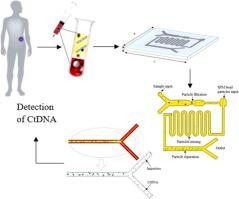Journal of Advanced Research ( IF 11.4 ) Pub Date : 2021-03-06 , DOI: 10.1016/j.jare.2021.03.001 Samla Gauri Balakrishnan 1 , Mohd Ridzuan Ahmad 1 , Seyed Saeid Rahimian Koloor 2 , Michal Petrů 2

|
Introduction
Conventional biopsy, based on extraction from a tumor of a solid tissue specimen requiring needles, endoscopic devices, excision or surgery, is at risk of infection, internal bleeding or prolonged recovery. A non-invasive liquid biopsy is one of the greatest axiomatic consequences of the identification of circulating tumor DNA (ctDNA) as a replaceable surgical tumor bioQpsy technique. Most of the literature studies thus far presented ctDNA detection at almost final stage III or IV of cancer, where the treatment option or cancer management is nearly impossible for diagnosis.
Objective
Hence, this paper aims to present a simulation study of extraction and separation of ctDNA from the blood plasma of cancer patients of stage I and II by superparamagnetic (SPM) bead particles in a microfluidic platform for early and effective cancer detection.
Method
The extraction of ctDNA is based on microfiltration of particle size to filter some impurities and thrombocytes plasma, while the separation of ctDNA is based on magnetic manipulation to high yield that can be used for the upstream process.
Result
Based on the simulation results, an average of 5.7 ng of ctDNA was separated efficiently for every 10 µL blood plasma input and this can be used for early analysis of cancer management. The particle tracing module from COMSOL Multiphysics traced ctDNA with 65.57% of sensitivity and 95.38% of specificity.
Conclusion
The findings demonstrate the ease of use and versatility of a microfluidics platform and SPM bead particles in clinical research related to the preparation of biological samples. As a sample preparation stage for early analysis and cancer diagnosis, the extraction and separation of ctDNA is most important, so precision medicine can be administered.
中文翻译:

微流控平台中超顺磁珠颗粒分离 ctDNA 用于早期癌症检测
介绍
传统的活检基于从肿瘤中提取实体组织样本,需要针头、内窥镜装置、切除或手术,存在感染、内出血或恢复时间延长的风险。无创液体活检是循环肿瘤 DNA (ctDNA) 鉴定为可替代的外科肿瘤活检技术的最大公理结果之一。迄今为止,大多数文献研究都在癌症的几乎最后阶段进行了 ctDNA 检测,此时治疗方案或癌症管理几乎不可能进行诊断。
客观的
因此,本文旨在提出一种在微流体平台中通过超顺磁(SPM)珠颗粒从 I 期和 II 期癌症患者血浆中提取和分离 ctDNA 的模拟研究,以实现早期有效的癌症检测。
方法
ctDNA的提取基于粒径的微滤,过滤一些杂质和血小板血浆,而ctDNA的分离基于磁力操作,产量高,可用于上游过程。
结果
根据模拟结果,每 10 µL 血浆输入平均可有效分离 5.7 ng ctDNA,这可用于癌症管理的早期分析。COMSOL Multiphysics 的粒子追踪模块追踪 ctDNA 的灵敏度为 65.57%,特异性为 95.38%。
结论
研究结果证明了微流体平台和 SPM 珠颗粒在与生物样品制备相关的临床研究中的易用性和多功能性。作为早期分析和癌症诊断的样品制备阶段,ctDNA的提取和分离至关重要,因此可以进行精准医疗。











































 京公网安备 11010802027423号
京公网安备 11010802027423号